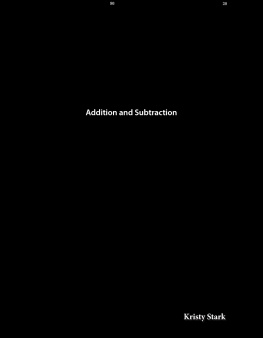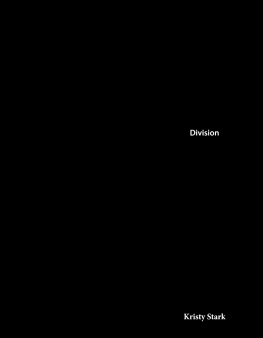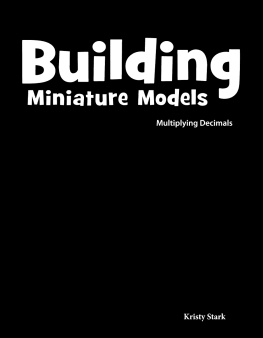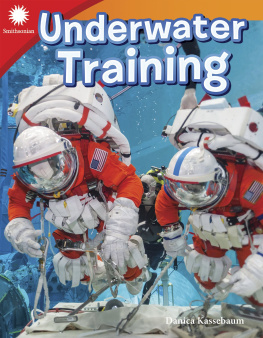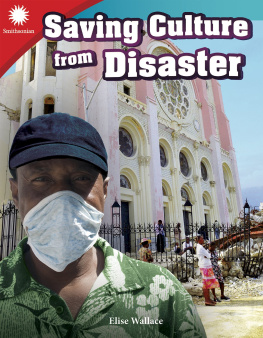Kristy Stark - Predicting Earthquakes
Here you can read online Kristy Stark - Predicting Earthquakes full text of the book (entire story) in english for free. Download pdf and epub, get meaning, cover and reviews about this ebook. year: 2018, publisher: Triangle Interactive, LLC, genre: Art. Description of the work, (preface) as well as reviews are available. Best literature library LitArk.com created for fans of good reading and offers a wide selection of genres:
Romance novel
Science fiction
Adventure
Detective
Science
History
Home and family
Prose
Art
Politics
Computer
Non-fiction
Religion
Business
Children
Humor
Choose a favorite category and find really read worthwhile books. Enjoy immersion in the world of imagination, feel the emotions of the characters or learn something new for yourself, make an fascinating discovery.
- Book:Predicting Earthquakes
- Author:
- Publisher:Triangle Interactive, LLC
- Genre:
- Year:2018
- Rating:5 / 5
- Favourites:Add to favourites
- Your mark:
- 100
- 1
- 2
- 3
- 4
- 5
Predicting Earthquakes: summary, description and annotation
We offer to read an annotation, description, summary or preface (depends on what the author of the book "Predicting Earthquakes" wrote himself). If you haven't found the necessary information about the book — write in the comments, we will try to find it.
Predicting Earthquakes — read online for free the complete book (whole text) full work
Below is the text of the book, divided by pages. System saving the place of the last page read, allows you to conveniently read the book "Predicting Earthquakes" online for free, without having to search again every time where you left off. Put a bookmark, and you can go to the page where you finished reading at any time.
Font size:
Interval:
Bookmark:
0covercover.xhtmlcover1page0001page0001.xhtml22page0002page0002.xhtmlPredicting Earthquakes33page0003page0003.xhtml44page0004page0004.xhtmlTable of Contents Shake and Quake 4 Movement in Earth's Crust 6 The Right Tools for the Job 10 Dangers after a Quake 16 Safety First 20 Preparing for the Big One 26 STEAM Challenge 28 Glossary 30 Index 31 Career Advice 3255page0005page0005.xhtmlShake and Quake You are sound asleep in your bed. Then, the bed starts to shake. You look around to see if your dog has jumped on the bed. A few books fall off your bookshelf. You hear your windows rattle. You finally realize : it's an earthquake! What causes earthquakes, or quakes? Most quakes occur along cracks, or faults, in Earth's crust. Molten lava under the crust allows enormous pieces of land, called tectonic plates, to move and shift. Some of these plates slide past one another. Some push against one another. Other plates move away from each other. When a plate collides into or slides over another plate, it builds up a lot of energy. When too much energy builds up, it needs to be released. The release of this energy is what causes the earth to shake. The blue lines on this map show where two plates meet.66page0006page0006.xhtmlSome plates move toward each other. Some plates move away from each other. Some plates slide next to each other.77page0007page0007.xhtmlMovement in Earth's Crust Scientists now know that most earthquakes are caused by tectonic plates. These plates are always moving. They bump into and move away from each other. But people didn't always know this to be true. For years, they would not believe that the land could be moving. A Good Fit Abraham Ortelius (ohr-TEE-lee-uhs) made the first atlas in the late sixteenth century. An atlas is a book of maps. In it, he pointed out that South America and Africa looked like they fit together like puzzle pieces. Other people agreed. They looked for more clues that the two places were once connected. Some found rocks in both places that seemed to match up. Others found similar plants and animals. These men did not know what might have caused the land to break apart. But they were the first to write about this theory. In science, a theory is based on evidence that tells why something happened. It took a long time before enough evidence was found to change people's minds. South America and Africa look like they could fit together like puzzle pieces.88page0008page0008.xhtmlAbraham Ortelius Science Earth's Structure Earth has several layers. The crust is the outer layer. It includes land and oceans. The layer under the crust is the mantle. It is made of really hot rock. The top of this layer is partly molten. Next is the outer core. It is made of molten iron and nickel. The inner core is the deepest layer. It is made of solid iron and nickel.99page0009page0009.xhtmlTwo hundred years passed. In 1799, Alexander von Humboldt went to South America. He found rocks on the east coast that looked like rocks on the west coast of Africa. He also thought the two landmasses had once been joined. More explorers found clues that supported this idea. They found similar species of animals that lived in both South America and Africa. They found fossils of the species in both lands, too. Below the Sea By the late 1960s, most experts thought that all Earth's land was once joined. But they were not sure how or why this changed. W. Jason Morgan and Dan McKenzie thought that Earth was covered with huge slabs of rock, or plates. They thought the slabs once fit like a puzzle. They thought the slabs moved in a lot of directions. Over time, the plates moved farther apart. rock from the east coast of South America rock from the west coast of Africa1010page0010page0010.xhtmlDivers swim where two plates meet in Iceland. Tectonic plates move from 2 to 5 centimeters (1 to 2 inches) per year. That is about the same speed that fingernails grow.1111page0011page0011.xhtmlThe Right Tools for the Job Scientists called seismologists (size-MAH-luh-jists) study earthquakes. They try to forecast when earthquakes will occur. They use special tools and machines to help them with their work. In fact, people have been tracking earthquakes with tools and devices for close to 2, 000 years! Seismoscope The first known device used to detect quakes was made in AD 132 by Zhang Heng (JAHNG huhng). Zhang studied astronomy, geography, and math in China. His seismoscope looked like a large jug made of bronze. It looked more like a piece of art than a scientific tool. There were eight dragons around the outside of the jug. The mouth of each dragon held a bronze ball. Bronze toads lined the foot of the jug. When the earth shook, a dragon's mouth opened. The ball dropped into a toad's mouth. The sound of the ball dropping let people know that an earthquake had occurred. People could also tell from which direction the earthquake came by seeing which ball had dropped. sketches of the seismoscope's interior1212page0012page0012.xhtmlmodel of Zhang Heng's seismoscope Arts Form and Function In art and design, form refers to the look and shape of the object. Function refers to the use of the object. Zhang's device combined form and function. The form of the tool was pleasing to the eye. It was built to be a beautiful sculpture. But this tool also served a purpose. The lovely bronze dragons, toads, and balls performed a function. The tool proved to be accurate in detecting earthquakes.1313page0013page0013.xhtmlZhang's tool was accurate and sensitive. One day, in AD 138, a ball dropped. But no one felt the earth shake. Some people thought the device did not work. They soon changed their minds. A few days later, a messenger came to say that an earthquake had struck the Gansu Province. That region was 644 kilometers (400 miles) away from the tool. Later, bronze balls were replaced with thick liquids in glass tubes. The liquids were used to find the strength of the quake. When the ground shook, the liquid moved in the tubes. It coated the sides of the glass tubes. The stronger the quake, the higher the liquid went in the tubes. This was better than the bronze balls, but it still needed work. Another problem with seismoscopes was that they could not record when the quake happened. A new tool was needed that would improve the seismoscope. This map shows the location of Zhang's seismoscope and the earthquake in Gansu Province. earthquake seismoscope1414page0014page0014.xhtmlThe strongest earthquake in U.S. history took place in Alaska. It happened on March 28, 1964. Alaska has had more earthquakes than any other state. In 1964, an earthquake in Alaska caused a lot of damage with its 30?foot?high waves.1515page0015page0015.xhtmlSeismographs Seismographs measure the strength of an earthquake. Some of the first machines used a pendulum. Quakes caused the pendulum to swing. Experts measured how much it moved. Now, most scientists use digital seismographs. These devices note movements in the earth. They show the movements as digital lines on a computer screen. Other machines have a large drum with paper. These seismographs use a weight and a pen. They are mounted to the ground. When the ground quakes, the pen moves. The pen makes lines on the roll of paper. Seismographs make lines that show the intensity of an earthquake. This record is called a seismogram. Short lines show that a quake is small. Long lines show that an earthquake is large. Experts use these lines to figure out the magnitude of the quake. Each earthquake is assigned a magnitude using a scale. The more energy that is released during an earthquake, the higher the magnitude. seismogram shown on a computer screen1616page0016page0016.xhtmlThis man looks at readings on a paper seismograph. Mathematics How to Measure Magnitude The scale used to measure earthquakes is not a device. It is a math formula. Experts use data about the intensity of seismic waves. This data is put into a formula. Then, the magnitude, or strength, is determined.1717page0017page0017.xhtmlDangers after a Quake Earthquakes can be dangerous. They can cause old structures and buildings to crumble to the ground. However, most deaths come from other effects caused by quakes. Earthquakes can trigger other dangerous disasters. Fire In 1906, San Francisco experienced a strong earthquake. It was one of the most destructive quakes in history. The quake itself destroyed many buildings. But the fires that started after the quake caused even more damage. Gas pipes broke. Gas quickly filled the air. Sparks from fallen electrical wires set the gas on fire. This started many fires in the city. The quake also caused water mains to break. So firefighters did not have water to put out the fires. The fires burned for three days. The flames destroyed about three-fourths of the city.1818page0018page0018.xhtmlAfter the 1906 San Francisco quake, firefighters used dynamite to try to stop fires. They blew up buildings hoping to create a break between the flames. But the explosions led to more fires.1919page0019page0019.xhtmlAftershocks After an earthquake, there is often more shaking as the ground settles. These aftershocks are usually smaller than the first earthquake. But they can still cause more damage. They can make buildings that were damaged by the initial quake fall to the ground. Tsunami Earthquakes can also cause tsunamis (su-NAH-mis). A tsunami starts as a wave under the ocean. The wave builds. It can reach 15 to 30 meters (50 to 100 feet) tall! Waves can travel quite fast and far. They can move at more than 724 km (450 mi.) per hour in deep water. When they reach land, even short waves are so powerful that they can lift cars and toss houses and ships. Avalanche Earthquakes near mountains can loosen the snowpack. Snow can slide down mountains with powerful force. It often buries people and things in its path. This truck has been crushed under snow during an avalanche.2020page0020page0020.xhtml1 An earthquake happens. 2 Waves start building out at sea. 3 Water rushes out right before a tsunami. 4 Water pushes forward with great force. Tsunamis used to be called tidal waves. That name is no longer used because the waves are not related to ocean tides. They are caused by earthquakes and volcanoes. destruction from a tsunami2121page0021page0021.xhtmlSafety First Seismologists do not have an easy job. To collect data, they have to work outside in all types of weather. They often work through the night. They may have to travel to remote places to install or repair equipment. So, why do they work so hard to track the earth's tremors? Why is it so important to study earthquakes? Their primary goal is to keep people safe. By studying quakes, they can help protect people from injury and death. Mapping Fault Lines Not all earthquakes are destructive. In fact, every day there are quakes that people do not notice or feel. But it is still crucial for scientists to know about those quakes. Tracking earthquakes can help them know which places shake more than others. They can map fault lines. This way, they know where quakes are most likely to occur. This information can warn people ahead of time so they can be more prepared. Seismologists study data. destruction caused by an earthquake2222page0022page0022.xhtmlThe San Andreas Fault (above) runs along the coast of California. San Francisco and Los Angeles get 5. 08 cm (2 in.) closer to each other each year because the two sides of the fault slip past each other.2323page0023page0023.xhtmlA Warning System Experts know where earthquakes are likely to take place. But they do not know when they will happen. They have tools that help detect quakes a few seconds before they happen. They can use this data to warn people. The United States Geological Survey (USGS) made a system that sends alerts before shaking starts. The system uses sensors. It is called ShakeAlert. The warning may come a few seconds or half a minute before the shaking starts. The amount of time depends on how far people's homes are from the epicenter (EH-pih-sehn-tuhr) of the quake. But even a few seconds can help. It gives people time to take cover. The system is now being tested on the west coast of the United States. This area has many strong earthquakes. Testers have used the system in California since 2012. The USGS hopes to roll it out to the public in the near future. Scientists at the USGS use many tools to help them predict and monitor earthquakes.2424page0024page0024.xhtmlThis earthquake monitor is powered by solar energy. Technology ShakeAlert California has about 400 ground motion sensors near known faults. They sense when the ground shakes. Then, ShakeAlert sends a warning message to users. The system tracks the quake's waves. It tells how much time until the waves will reach the user. It predicts the intensity and magnitude of the quake, too.2525page0025page0025.xhtmlBuilding Strong Structures Buildings can be dangerous in an earthquake. At times, old or poorly built structures cannot hold up. The force of a quake might be too strong. Buildings may fall. People and pets may get trapped. Architects work to build structures that can withstand earthquakes. These buildings are made of steel and concrete. They have strong foundations. The Transamerica Pyramid is in San Francisco. Its foundation is 16 m (52 ft.) deep. It has lasted through a lot of earthquakes. A skyscraper was built in Mexico City that experts thought could hold up in a magnitude 8. 5 quake. In 2017, the building was put to the test. The city had a magnitude 7. 1 quake. The building stood up to its force! Experts work to retrofit old buildings, too. They fix structures so they can survive earthquakes. Shock absorbers are installed on the buildings. They control movements in the foundations. Transamerica Pyramid in San Francisco, CA foundation2626page0026page0026.xhtmlThis device was built under a building to absorb the shock of an earthquake. Engineering Shake and Sway Engineers design tall skyscrapers to withstand quakes. You might think the buildings are rigid. They are not! Engineers build the upper floors so that they move and sway with the motion of earthquakes. People can see these buildings move during a quake. While this flexibility might look scary, it keeps the buildings from snapping and crumbling.2727page0027page0027.xhtmlPreparing for the Big One Being prepared for an earthquake can mean the difference between life and death. No one knows when a big quake might strike. Many schools have drills so students and teachers will know what to do if there is a real quake. They learn to crawl under sturdy desks or tables to protect their heads. Firefighters and police officers do drills, too. They learn how to locate people who might be trapped after a quake. Some even have dogs that are trained to sniff out people who might be trapped under rubble. Many people live in places where quakes are likely. They need to make earthquake kits. The kits should have a supply of bottled water. The kits should have flashlights and blankets, too. They should also have nonperishable food for everyone in the home. Do you live in a place where an earthquake is likely to happen? If so, be prepared! rescue dog rescue workers2828page0028page0028.xhtmlEarthquake shelters are stocked with plenty of food and water. About half of cell phone users do not have their family members' phone numbers memorized. It is good to know these numbers in case cell phone service goes out in an emergency.2929page0029page0029.xhtmlSTEAM CHALLENGE Define the Problem How can a building protect people and property during an earthquake? Engineers think about this question when they design buildings near faults. Your task is to design and build a structure that can hold up during an earthquake. In the process, you will discover how engineers approach this problem! Constraints : Your structure must be at least two stories tall. It must be able to hold a small bag of sand at each story. Criteria : Your model should survive a 30-second shake test.3030page0030page0030.xhtml1 Research and Brainstorm How does the movement of Earth's plates lead to an earthquake? How do scientists know where earthquakes may occur? What types of materials are used for buildings near a fault? 2 Design and Build Sketch your design. What purpose will each part of the structure serve? What materials will work best? Build the model. 3 Test and Improve Test your model using a shake test. Did it work? How can you improve it? Modify your design, and try again. 4 Reflect and Share Could you make a taller structure? What materials could make it stronger? What other types of natural events do engineers think about when they design a building?3131page0031page0031.xhtmlGlossary epicenter spot on Earth's surface directly above the place where an earthquake starts foundations stone or concrete structures that support a building from underneath intensity the amount of strength or force that something has magnitude a number that shows the strength and power of an earthquake nonperishable not likely to spoil or decay pendulum a stick or string with a weight at the bottom that swings back and forth retrofit to add new parts to something that were not available when it was first built seismogram the data produced by a seismograph seismographs devices that measure and record the earth's movement during an earthquake seismologists people who study earthquakes seismoscope a device that measures the direction from which an earthquake occurs sensitive able to sense very small changes tectonic plates the slabs of Earth's crust that are broken into sections theory an explanation about why something happens that is supported by evidence3232page0032page0032.xhtmlIndex Africa California China fault Humboldt, Alexander von Los Angeles McKenzie, Dan Mexico City Morgan, W. Jason Ortelius, Abraham San Andreas Fault San Francisco ShakeAlert South America Transamerica Pyramid United States Geological Survey (USGS) Zhang Heng3333page0033page0033.xhtmlCareer Advice from Smithsonian Do you want to study earthquakes? Here are some tips to get you started. To understand earthquakes, you need to study geology. You should also take physics, math, and computer science classes. Not all seismologists study earthquakes. Some work for oil and gas companies and help find energy resources in the ground. Other seismologists study volcanoes and volcanic eruptions. Benjamin Andrews, Director, Global Volcanism Program Some engineers design earthquake-resistant buildings. If this is a job you want, then study architecture, math, physics, and drafting. You can combine creativity, engineering, and science. And, more importantly, you'll help save lives! Sharon Park, Associate Director, Architectural History and Historic Preservation3434page0034page0034.xhtmlRead and Respond 1. What are tectonic plates? 2. Why are some areas more likely to have earthquakes than others? 3. Compare and contrast aftershocks, tsunamis, and avalanches. 4. How would life change if we could predict earthquakes days in advance? 5. What do you think is the most important achievement in the study of earthquakes? Why? 6. Write a journal entry as someone who is experiencing an earthquake. Describe what you see and hear around you.35
Next pageFont size:
Interval:
Bookmark:
Similar books «Predicting Earthquakes»
Look at similar books to Predicting Earthquakes. We have selected literature similar in name and meaning in the hope of providing readers with more options to find new, interesting, not yet read works.
Discussion, reviews of the book Predicting Earthquakes and just readers' own opinions. Leave your comments, write what you think about the work, its meaning or the main characters. Specify what exactly you liked and what you didn't like, and why you think so.


